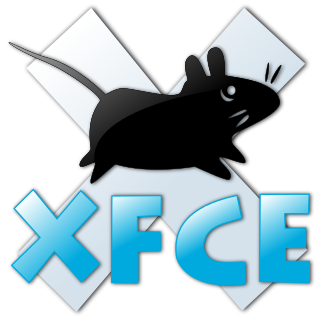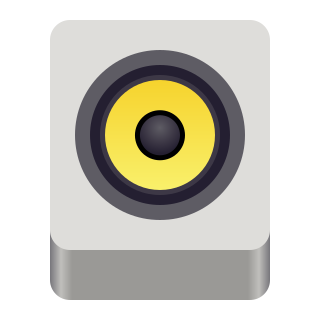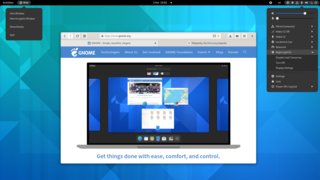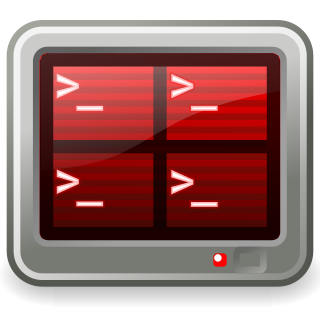
Xfce or XFCE is a free and open-source desktop environment for Linux and Unix-like operating systems.

GNOME Evolution is the official personal information manager for GNOME. It has been an official part of GNOME since Evolution 2.0 was included with the GNOME 2.8 release in September 2004. It combines e-mail, address book, calendar, task list and note-taking features. Its user interface and functionality is similar to Microsoft Outlook. Evolution is free software licensed under the terms of the GNU Lesser General Public License (LGPL).

Metacity was the default window manager used by the GNOME 2 desktop environment until it was replaced by Mutter in GNOME 3. It is still used by GNOME Flashback, a session for GNOME 3 that provides a similar user experience to the Gnome 2.x series sessions.

Rhythmbox is a free and open-source audio player software, tag editor and music organizer for digital audio files on Linux and Unix-like systems.

Compiz is a compositing window manager for the X Window System, using 3D graphics hardware to create fast compositing desktop effects for window management. Effects, such as a minimization animation or a cube workspace, are implemented as loadable plugins. Because it conforms to the ICCCM standard, Compiz can be used as a substitute for the default Mutter or Metacity, when using GNOME Panel, or KWin in KDE Plasma Workspaces. Internally Compiz uses the OpenGL library as the interface to the graphics hardware.

Dreamlinux was a Brazilian computer operating system based on Debian Linux. It can boot as a live CD, from USB flash drive, or can be installed on a hard drive. The distribution's GUI aims to have a centered animated toolbar. As of October 2012, The Dreamlinux Project has been discontinued.

GNOME Panel is a highly configurable taskbar for GNOME. It formed a core part of the GNOME desktop in versions 1.x and 2.x. It has been replaced in GNOME 3.x by default with GNOME Shell, which only works with the Mutter window manager.

LXDE is a free desktop environment with comparatively low resource requirements. This makes it especially suitable for use on older or resource-constrained personal computers such as netbooks or system on a chip computers.
Strigi was a file indexing and file search framework adopted by KDE SC. Strigi was initiated by Jos van den Oever. Strigi's goals are to be fast, use a small amount of RAM, and use flexible backends and plug-ins. A benchmark as of January 2007 showed that Strigi is faster and uses less memory than other search systems, but it lacks many of their features. Like most desktop search systems, Strigi can extract information from files, such as the length of an audio clip, the contents of a document, or the resolution of a picture; plugins determine what filetypes it is capable of handling. Strigi uses its own Jstream system which allows for deep indexing of files. Strigi is accessible via Konqueror, or by clicking on its icon, after adding it to KDE's Kicker or GNOME Panel. The graphical user interface (GUI) is named Strigiclient.

gOS or "good OS" was an Ubuntu-based Linux distribution created by Good OS LLC, a Los Angeles-based corporation. Its CIO David Liu described that after meeting Enlightenment and open source people, he realized that his dream to bring Web 2.0 applications into mainstream use could be achieved by creating a Linux distribution that made it easy for users to access Google and Web 2.0 applications. David Liu went on to create the Chinese Twitter clone called Wozai (我在), leaving gOS officially defunct.

GTK is a free and open-source cross-platform widget toolkit for creating graphical user interfaces (GUIs). It is licensed under the terms of the GNU Lesser General Public License, allowing both free and proprietary software to use it. It is one of the most popular toolkits for the Wayland and X11 windowing systems.

GNOME is a free and open-source desktop environment for Unix-like operating systems. GNOME was originally an acronym for GNU Network Object Model Environment, but the acronym was dropped because it no longer reflected the vision of the GNOME project.

GNOME Shell is the graphical shell of the GNOME desktop environment starting with version 3, which was released on April 6, 2011. It provides basic functions like launching applications, switching between windows and is also a widget engine. GNOME Shell replaced GNOME Panel and some ancillary components of GNOME 2.
Mutter is a window manager initially designed and implemented for the X Window System, but then evolved to be a Wayland compositor. It became the default window manager in GNOME 3, replacing Metacity which used GTK for rendering.

MATE is a desktop environment composed of free and open-source software that runs on Linux and BSD operating systems.

Zim is a graphical text editor designed to maintain a collection of locally stored wiki-pages, a personal wiki. Each wiki-page can contain things like text with simple formatting, links to other pages, attachments, and images. Additional plugins, such as an equation editor and spell-checker, are also available. The wiki-pages are stored in a folder structure in plain text files with wiki formatting.

Cinnamon is a free and open-source desktop environment for the X Window System that derives from GNOME 3 but follows traditional desktop metaphor conventions. Cinnamon is the principal desktop environment of the Linux Mint distribution and is available as an optional desktop for other Linux distributions and other Unix-like operating systems as well.

Budgie is a desktop environment that uses GNOME technologies such as GTK and is developed by the Solus project as well as by contributors from numerous communities such as Arch Linux, Manjaro, openSUSE Tumbleweed and Ubuntu Budgie. Budgie's design emphasizes simplicity, minimalism and elegance.

Pop!_OS is a free and open-source Linux distribution, based upon Ubuntu, featuring a custom GNOME desktop. The distribution is developed by American Linux computer manufacturer System76. Pop!_OS is primarily built to be bundled with the computers built by System76, but can also be downloaded and installed on most computers.

GNOME Terminator is an free and open-source terminal emulator for Linux programmed in Python, licensed under GPL-2.0-only. The goal of the project is to produce a useful tool for arranging terminals. It is inspired by programs such as gnome-multi-term, quadkonsole, etc. In that the main focus is arranging terminals in grids. Terminator exists in default repositories for Arch, Debian/Ubuntu, Fedora, OpenSUSE, Gentoo, Snap, FreeBSD. In 2017 took second place in voting at opensource.com, after Gnome Terminal. Terminator is not a fork of GNOME Terminal, It is a development from scratch of Chris Jones, entirely in Python, but much of the behavior of Terminator is based on GNOME Terminal:... Terminator began by copying code from the vte-demo.py in the vte widget package, and the gedit terminal plugin.


















